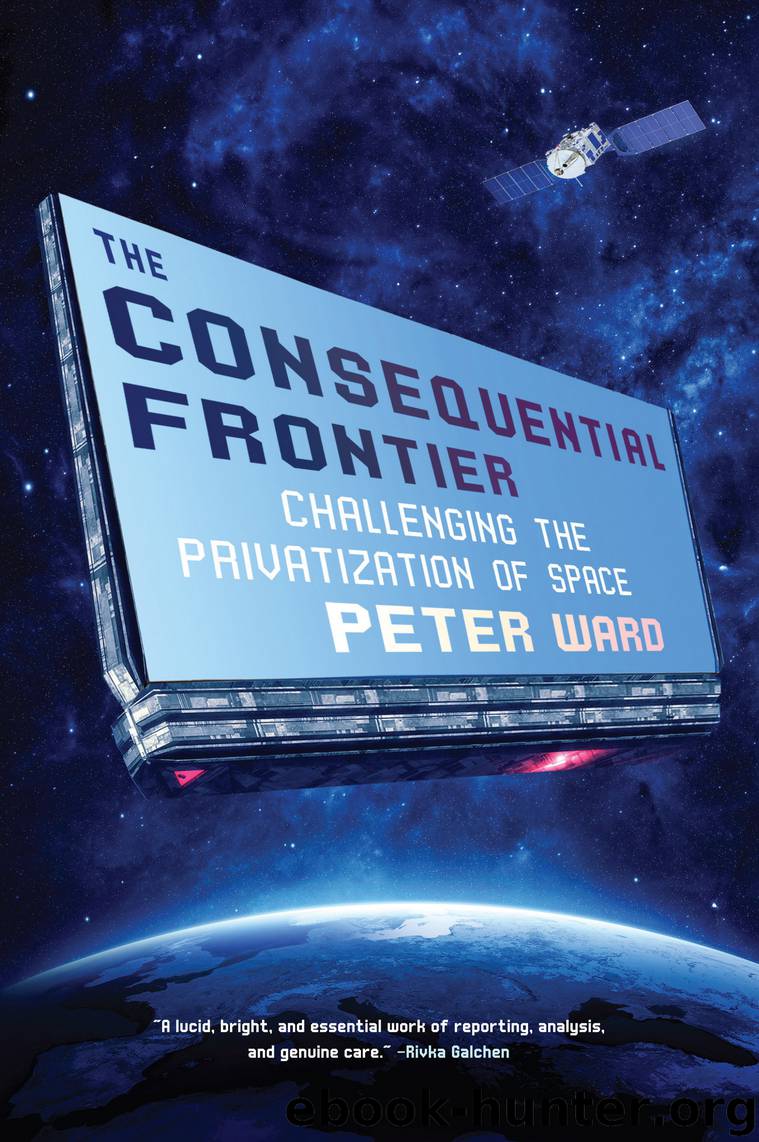The Consequential Frontier by Peter Ward

Author:Peter Ward
Language: eng
Format: epub
Publisher: Melville House
Published: 2019-10-14T16:00:00+00:00
8
The Newcomers
IN JANUARY 2007, CHINA TESTED ITS CAPABILITY TO SHOOT down a satellite from Earth. In a move widely condemned around the world, the Chinese government launched a kinetic kill vehicle—essentially a weapon catapulted into space to smash into and destroy another object—directly at a weather satellite, hitting it, and breaking it up into tiny pieces.1 This one incident is said to have increased the amount of trackable space debris by 25 percent, according to the European Space Agency (ESA).2 It was a flamboyant way to announce itself as a major player in the space game, but hardly ideal. In 2019, though, China managed to do something not even the Americans or Russians had done, despite their considerable head start.
On the morning of January 3, the Chang’e 4 lander, named after the Chinese goddess of the Moon, touched down on the far side of Earth’s largest natural satellite at 10:26 a.m. Shanghai time.3 It was the first-ever soft landing on the side of the Moon not viewable from Earth, and opened up a host of scientific possibilities. It also reminded the world that China’s space program is one of the most advanced in the world, and it is making the kind of steady progress that could establish it as the leading nation in space in a few decades’ time. Emerging from the shadows, a robust space program from the most populous country in the world could reignite the government-led space race, introduce a number of new private companies into the fold, and even speed up various missions to Mars.
The Chang’e 4 mission was the result of meticulous and patient planning. NASA and Russia have never landed a human or robot on the far side of the Moon, primarily because communication is nearly impossible. When Apollo-era astronauts reached the other side of the Moon during orbits, they’d lose contact with Houston, immersed in the peace and tranquility of space while observing views of the cosmos never seen before by humans. The far side is also sometimes referred to as the dark side of the Moon but that’s not accurate. The rotation speed of the Moon is synched with the Earth’s—a result of the gravitational forces applied during the 4.5 billion years the Moon has orbited the planet—such that one side of the Moon is always facing away from Earth and can’t be seen. That there could exist an unknown half of a celestial body so close to Earth has led to many myths and legends and claims that it is permanently dark. But the opposite half of the Moon does in fact get as much light from the Sun as the half we can see. When the section of the Moon viewable from Earth is dark and not visible in the night sky, the other side is completely lit up.
The difficulty in exploring the far side is that communications between Earth and a spacecraft are blocked by the Moon itself. China remedied this in May 2018, when it launched the Queqiao,
Download
This site does not store any files on its server. We only index and link to content provided by other sites. Please contact the content providers to delete copyright contents if any and email us, we'll remove relevant links or contents immediately.
| Aerodynamics | Aircraft Design & Construction |
| Astronautics & Space Flight | Avionics |
| Gas Dynamics | Propulsion Technology |
Whiskies Galore by Ian Buxton(41489)
Introduction to Aircraft Design (Cambridge Aerospace Series) by John P. Fielding(32852)
Small Unmanned Fixed-wing Aircraft Design by Andrew J. Keane Andras Sobester James P. Scanlan & András Sóbester & James P. Scanlan(32533)
Craft Beer for the Homebrewer by Michael Agnew(17902)
Turbulence by E. J. Noyes(7659)
The Complete Stick Figure Physics Tutorials by Allen Sarah(7096)
Kaplan MCAT General Chemistry Review by Kaplan(6545)
The Thirst by Nesbo Jo(6405)
Bad Blood by John Carreyrou(6245)
Modelling of Convective Heat and Mass Transfer in Rotating Flows by Igor V. Shevchuk(6200)
Learning SQL by Alan Beaulieu(5994)
Weapons of Math Destruction by Cathy O'Neil(5778)
Man-made Catastrophes and Risk Information Concealment by Dmitry Chernov & Didier Sornette(5586)
Digital Minimalism by Cal Newport;(5323)
Life 3.0: Being Human in the Age of Artificial Intelligence by Tegmark Max(5144)
iGen by Jean M. Twenge(5125)
Secrets of Antigravity Propulsion: Tesla, UFOs, and Classified Aerospace Technology by Ph.D. Paul A. Laviolette(4858)
Design of Trajectory Optimization Approach for Space Maneuver Vehicle Skip Entry Problems by Runqi Chai & Al Savvaris & Antonios Tsourdos & Senchun Chai(4805)
Electronic Devices & Circuits by Jacob Millman & Christos C. Halkias(4698)
